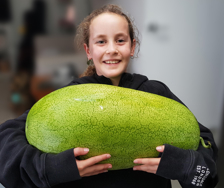Yates Account
Join now
Create a Yates account today!
Sign up to join the Yates Garden Club for monthly e-mails packed with seasonal inspiration, tips for success & exclusive promotions.
Plus if you’re a Garden Club member you can take part in the Yates Growing Community - a blog to share successes, get advice & win prizes in fun challenges along the way!

Forgot password
Enter the email address associated with your account, and we'll email you a new password.

If you ask us, we’d have salad on the menu every day of the year. The beauty of a fresh salad is that it reflects the season, especially if the ingredients are coming out of your garden.
Even so, there’s something extra special about spring salads. Read on for ideas and inspiration!
Fresh Ingredients
Spring is all about freshness. Use crisp, tender greens like spinach, lettuce, rocket, or mesclun as a base. The more varieties and textures you can add, the better; it makes a salad much more appealing than just having a solo leafy green.
We have two heirloom lettuces with distinctively different leaves to give colour and texture contrast in your salads. Green Oak Leaf Lettuce has longer lobed leaves with a sweet non-bitter flavour. Petite Tom Thumb Lettuce has round shaped leaves and is easy to grow in even the smallest gardens or pots.
This is where having a kitchen garden comes into its own: just pop outside and pick what you need. The fresher the vegies, the better they taste. Lettuce, radish, spinach and leafy herbs can be grown from September to May in most of NZ.
Use What’s in Season
Lots of classic favourites are ready for harvest in spring. Beetroot, carrots and yams are all easy to come by and add a touch of earthy goodness.
For more vibrant flavours, seasonal fruits and vegetables like strawberries, asparagus, peas, broccoli, radishes, and avocados all elevate a salad into very tasty territory. There’s a lot of delicious choice during spring.
Go For Texture and Variety
Add crunch with nuts (walnuts, almonds) or seeds (pumpkin or sunflower seeds) and grainy bread croutons (if you’re not a fan of bread crust – use it for croutons).
Add creaminess with cheese (feta or blue cheese).
A salad is so much better with little pops of contrasting texture while you’re eating it!

Add Protein
Include lean proteins like chicken, tuna, or tofu to make your salad more filling. This is a sneaky way of turning a salad into the main event, not just a side dish.
Pairing protein with nuts, grains, potatoes, or kūmara really boosts the carbohydrate content too, so your salad can be a single-dish square meal if you want. Adding rice, bulgur wheat, couscous or orzo are also ideal to make a salad into a substantial, filling dish.
Dress for Success
You can’t go wrong with light, fresh dressings like vinaigrettes, with generous notes of citrus juice, zest, garlic and mustard.
Don’t overlook yoghurt, mayonnaise, or sour cream-based dressings, they all bring something special to the party.
Adding herb-infused flavours to dressings also really complements the base ingredients.
Sweet AND Savoury
Balance flavours by combining sweet elements like fruits with savoury components like cheese; or playing off sweetness against the acid notes of vinaigrette. Pickled gherkins, capers or kimchi work really well for this too.

Herbs FTW
Fresh herbs like basil, mint, chives or coriander can add an incredible lift to your salad. Yet another reason to keep your herb garden close to your kitchen door.
Make it Look Pretty
Choose ingredients for pops of vibrant colour and contrast. A visually appealing salad is more enjoyable because your eyes are connected with your taste buds. OK, not really, but as a general rule if it looks nice, it’s going to taste nice.
Edible Flowers
For a bit of extra romance, sprinkle in edible flowers like nasturtiums or violas. This is probably the ultimate expression of the “Make It Look Pretty” school of salad design.
Experiment!
Don't be shy, experiment with different combinations of ingredients. Salads offer endless possibilities to play around and get creative.
















Share
Share this article on social media